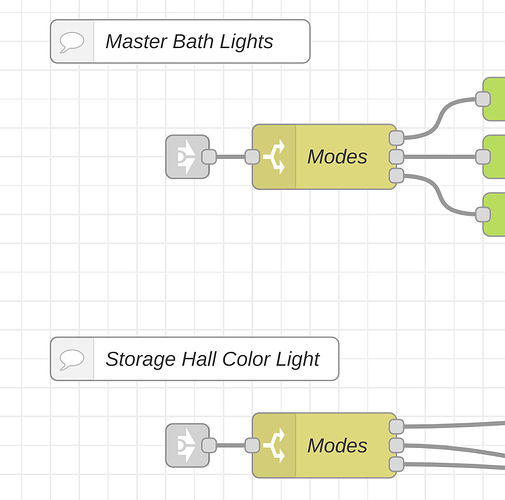[{"id":"20728976.2fb466","type":"tab","label":"Main","disabled":false,"info":""},{"id":"26d21393.9ccbbc","type":"switch","z":"20728976.2fb466","name":"Active/Inactive","property":"payload.value","propertyType":"msg","rules":[{"t":"eq","v":"active","vt":"str"},{"t":"eq","v":"inactive","vt":"str"}],"checkall":"true","repair":false,"outputs":2,"x":360,"y":260,"wires":[["2be60868.8db6d8"],["cbc258ee.37f138"]]},{"id":"28a89a9b.39e9a6","type":"change","z":"20728976.2fb466","name":"Stop when active","rules":[{"t":"set","p":"payload","pt":"msg","to":"stop","tot":"str"}],"action":"","property":"","from":"","to":"","reg":false,"x":1230,"y":180,"wires":[["786c65e8.956c0c","ea9e0581.7c23d8"]]},{"id":"858167fd.d57ba8","type":"switch","z":"20728976.2fb466","name":"is on?","property":"payload.value","propertyType":"msg","rules":[{"t":"eq","v":"on","vt":"str"}],"checkall":"true","repair":false,"outputs":1,"x":1050,"y":260,"wires":[["ea9e0581.7c23d8"]]},{"id":"d9696335.94e8f","type":"switch","z":"20728976.2fb466","name":"Active/Inactive","property":"payload.value","propertyType":"msg","rules":[{"t":"eq","v":"active","vt":"str"},{"t":"eq","v":"inactive","vt":"str"}],"checkall":"true","repair":false,"outputs":2,"x":340,"y":600,"wires":[["9ed9e6db.8eb478"],["797e7392.4c3f9c"]]},{"id":"9fe36ae7.803ac8","type":"change","z":"20728976.2fb466","name":"Stop when active","rules":[{"t":"set","p":"payload","pt":"msg","to":"stop","tot":"str"}],"action":"","property":"","from":"","to":"","reg":false,"x":930,"y":580,"wires":[["25e9e461.8b39ec","10b7710e.5d536f"]]},{"id":"2acfd99e.3916e6","type":"switch","z":"20728976.2fb466","name":"<150","property":"payload.value","propertyType":"msg","rules":[{"t":"lte","v":"150","vt":"str"}],"checkall":"true","repair":false,"outputs":1,"x":970,"y":520,"wires":[["9fe36ae7.803ac8"]]},{"id":"cef6cad3.9b9ed8","type":"switch","z":"20728976.2fb466","name":"<15","property":"payload.value","propertyType":"msg","rules":[{"t":"lte","v":"15","vt":"str"}],"checkall":"true","repair":false,"outputs":1,"x":1050,"y":140,"wires":[["28a89a9b.39e9a6"]]},{"id":"b9c43333.13c48","type":"switch","z":"20728976.2fb466","name":">60/<40","property":"payload.value","propertyType":"msg","rules":[{"t":"gte","v":"60","vt":"str"},{"t":"lte","v":"40","vt":"str"}],"checkall":"true","repair":false,"outputs":2,"x":340,"y":1040,"wires":[["3eddcd03.8c1442"],["e8ca5cf6.b0ccc"]]},{"id":"5939f110.26451","type":"switch","z":"20728976.2fb466","name":"open/closed","property":"payload.value","propertyType":"msg","rules":[{"t":"eq","v":"open","vt":"str"},{"t":"eq","v":"closed","vt":"str"}],"checkall":"true","repair":false,"outputs":2,"x":990,"y":820,"wires":[["8c6e375d.677898"],["a668770c.f1c1a8"]]},{"id":"25e9e461.8b39ec","type":"change","z":"20728976.2fb466","name":"CT6500k, 100%","rules":[{"t":"set","p":"payload","pt":"msg","to":"{\"on\":true, \"brightness\":100, \"colorTemp\":153}","tot":"json"}],"action":"","property":"","from":"","to":"","reg":false,"x":1160,"y":520,"wires":[["d78c7332.5f301"]]},{"id":"d2516ee7.d8b23","type":"change","z":"20728976.2fb466","name":"CT-6500k, 25%","rules":[{"t":"set","p":"payload","pt":"msg","to":"{\"on\":true, \"brightness\":15, \"colorTemp\":153}","tot":"json"}],"action":"","property":"","from":"","to":"","reg":false,"x":1480,"y":860,"wires":[["d7bb4810.9c1278"]]},{"id":"d78c7332.5f301","type":"hue-light","z":"20728976.2fb466","name":"Ensuite Light","bridge":"7dcda340.c6ab4c","lightid":"4","colornamer":true,"skipevents":false,"x":1350,"y":520,"wires":[[]],"info":"test"},{"id":"d7bb4810.9c1278","type":"hue-light","z":"20728976.2fb466","name":"Ensuite Light","bridge":"7dcda340.c6ab4c","lightid":"4","colornamer":true,"skipevents":false,"x":1650,"y":860,"wires":[[]],"info":"test"},{"id":"786c65e8.956c0c","type":"hubitat command","z":"20728976.2fb466","name":"MasterBed Switch ON","server":"26c9a23e.36f4ce","deviceId":"393","command":"on","commandArgs":"","x":1480,"y":180,"wires":[[]]},{"id":"d9e0980a.c3ad58","type":"hubitat command","z":"20728976.2fb466","name":"MasterBed Switch OFF","server":"26c9a23e.36f4ce","deviceId":"393","command":"off","commandArgs":"","x":1470,"y":120,"wires":[[]]},{"id":"67cfb696.9f0e58","type":"hubitat command","z":"20728976.2fb466","name":"Ensuite Exhaust Fan ON","server":"26c9a23e.36f4ce","deviceId":"484","command":"on","commandArgs":"","x":870,"y":1020,"wires":[[]]},{"id":"e8ca5cf6.b0ccc","type":"hubitat command","z":"20728976.2fb466","name":"Ensuite Exhaust Fan Switch (S2) OFF","server":"26c9a23e.36f4ce","deviceId":"484","command":"off","commandArgs":"","x":590,"y":1080,"wires":[[]]},{"id":"ef0e34d1.d88768","type":"hubitat device","z":"20728976.2fb466","name":"MasterBed Switch","server":"26c9a23e.36f4ce","deviceId":"393","attribute":"switch","sendEvent":false,"x":890,"y":260,"wires":[["858167fd.d57ba8"]]},{"id":"dd320a77.bc1048","type":"hubitat device","z":"20728976.2fb466","d":true,"name":"Ensuite MS (aeotec)","server":"26c9a23e.36f4ce","deviceId":"353","attribute":"motion","sendEvent":true,"x":180,"y":540,"wires":[["f7d2449c.c9eaf8"]]},{"id":"dbc4f832.3e62d8","type":"hubitat device","z":"20728976.2fb466","name":"Ensuite Humidity Sensor","server":"26c9a23e.36f4ce","deviceId":"353","attribute":"humidity","sendEvent":true,"x":130,"y":1040,"wires":[[]]},{"id":"c1343585.aa36d8","type":"change","z":"20728976.2fb466","name":"Turn Off","rules":[{"t":"set","p":"payload","pt":"msg","to":"false","tot":"bool"}],"action":"","property":"","from":"","to":"","reg":false,"x":1540,"y":740,"wires":[["ea49704a.21663"]]},{"id":"ea49704a.21663","type":"hue-light","z":"20728976.2fb466","name":"","bridge":"7dcda340.c6ab4c","lightid":"4","colornamer":true,"skipevents":false,"x":1680,"y":740,"wires":[[]]},{"id":"e521bd4d.4f816","type":"switch","z":"20728976.2fb466","name":"is on?","property":"payload.value","propertyType":"msg","rules":[{"t":"eq","v":"on","vt":"str"}],"checkall":"true","repair":false,"outputs":1,"x":1050,"y":80,"wires":[["d9e0980a.c3ad58"]]},{"id":"28482d90.56b802","type":"hubitat device","z":"20728976.2fb466","name":"MasterBed Switch","server":"26c9a23e.36f4ce","deviceId":"393","attribute":"switch","sendEvent":false,"x":890,"y":80,"wires":[["e521bd4d.4f816"]]},{"id":"8c6e375d.677898","type":"hubitat mode","z":"20728976.2fb466","name":"Mode","server":"26c9a23e.36f4ce","sendEvent":false,"x":1150,"y":800,"wires":[["1f45a598.de089a"]]},{"id":"a668770c.f1c1a8","type":"hubitat mode","z":"20728976.2fb466","name":"Mode","server":"26c9a23e.36f4ce","sendEvent":false,"x":1150,"y":860,"wires":[["8095726f.31e49"]]},{"id":"9ed9e6db.8eb478","type":"hubitat mode","z":"20728976.2fb466","name":"Mode","server":"26c9a23e.36f4ce","sendEvent":false,"x":510,"y":540,"wires":[["2f4512ab.9ec0ae"]]},{"id":"797e7392.4c3f9c","type":"hubitat mode","z":"20728976.2fb466","name":"Mode","server":"26c9a23e.36f4ce","sendEvent":false,"x":510,"y":620,"wires":[["f3d1b195.5a978"]]},{"id":"3f0f714e.666cfe","type":"switch","z":"20728976.2fb466","name":"Mode=Home","property":"payload.value","propertyType":"msg","rules":[{"t":"eq","v":"Home","vt":"str"}],"checkall":"true","repair":false,"outputs":1,"x":690,"y":200,"wires":[["74cd80d.0a4af8","c5f203eb.b1a5"]]},{"id":"2be60868.8db6d8","type":"hubitat mode","z":"20728976.2fb466","name":"Mode","server":"26c9a23e.36f4ce","sendEvent":false,"x":550,"y":200,"wires":[["3f0f714e.666cfe"]]},{"id":"9725d708.0222c8","type":"switch","z":"20728976.2fb466","name":"Mode=Home","property":"payload.value","propertyType":"msg","rules":[{"t":"eq","v":"Home","vt":"str"}],"checkall":"true","repair":false,"outputs":1,"x":690,"y":260,"wires":[["ef0e34d1.d88768"]]},{"id":"cbc258ee.37f138","type":"hubitat mode","z":"20728976.2fb466","name":"Mode","server":"26c9a23e.36f4ce","sendEvent":false,"x":550,"y":260,"wires":[["9725d708.0222c8"]]},{"id":"60b18d3c.7b2c34","type":"switch","z":"20728976.2fb466","name":">100","property":"payload.value","propertyType":"msg","rules":[{"t":"gte","v":"150","vt":"str"}],"checkall":"true","repair":false,"outputs":1,"x":730,"y":80,"wires":[["28482d90.56b802"]]},{"id":"3c418436.df0eac","type":"hubitat device","z":"20728976.2fb466","name":"Ensuite MS (hue)","server":"26c9a23e.36f4ce","deviceId":"673","attribute":"motion","sendEvent":true,"x":130,"y":600,"wires":[["d9696335.94e8f"]]},{"id":"506d4ba5.fd1be4","type":"hubitat device","z":"20728976.2fb466","name":"HUE MS LUX","server":"26c9a23e.36f4ce","deviceId":"673","attribute":"illuminance","sendEvent":false,"x":820,"y":520,"wires":[["2acfd99e.3916e6"]]},{"id":"2dea5e7c.ca36a2","type":"hubitat device","z":"20728976.2fb466","name":"HUE MS LUX","server":"26c9a23e.36f4ce","deviceId":"673","attribute":"illuminance","sendEvent":true,"x":910,"y":740,"wires":[["bd63adcb.24c0b"]]},{"id":"bd63adcb.24c0b","type":"switch","z":"20728976.2fb466","name":">200","property":"payload.value","propertyType":"msg","rules":[{"t":"gte","v":"200","vt":"str"}],"checkall":"true","repair":false,"outputs":1,"x":1050,"y":740,"wires":[["59d619e3.57cd78"]]},{"id":"59d619e3.57cd78","type":"hue-light","z":"20728976.2fb466","name":"Ensuite Light","bridge":"7dcda340.c6ab4c","lightid":"4","colornamer":true,"skipevents":false,"x":1190,"y":740,"wires":[["2d8c5f93.45a78"]],"info":"test"},{"id":"2d8c5f93.45a78","type":"switch","z":"20728976.2fb466","name":"is on?","property":"payload.value","propertyType":"msg","rules":[{"t":"eq","v":"on","vt":"str"}],"checkall":"true","repair":false,"outputs":1,"x":1330,"y":740,"wires":[["c1343585.aa36d8"]]},{"id":"22a2e5e8.6e8b9a","type":"switch","z":"20728976.2fb466","name":"open/closed","property":"payload.value","propertyType":"msg","rules":[{"t":"eq","v":"open","vt":"str"},{"t":"eq","v":"closed","vt":"str"}],"checkall":"true","repair":false,"outputs":2,"x":950,"y":620,"wires":[["c5d50385.e8ff8"],[]]},{"id":"8095726f.31e49","type":"switch","z":"20728976.2fb466","name":"Mode=Asleep","property":"payload.value","propertyType":"msg","rules":[{"t":"eq","v":"Asleep","vt":"str"}],"checkall":"true","repair":false,"outputs":1,"x":1300,"y":860,"wires":[["d2516ee7.d8b23"]]},{"id":"1f45a598.de089a","type":"switch","z":"20728976.2fb466","name":"Mode=Asleep","property":"payload.value","propertyType":"msg","rules":[{"t":"eq","v":"Asleep","vt":"str"}],"checkall":"true","repair":false,"outputs":1,"x":1300,"y":800,"wires":[["c1343585.aa36d8"]]},{"id":"f3d1b195.5a978","type":"switch","z":"20728976.2fb466","name":"H/Q","property":"payload.value","propertyType":"msg","rules":[{"t":"eq","v":"Home","vt":"str"},{"t":"eq","v":"Quiet","vt":"str"}],"checkall":"true","repair":false,"outputs":2,"x":630,"y":620,"wires":[["3fd24923.a7ac16"],["3fd24923.a7ac16"]]},{"id":"2f4512ab.9ec0ae","type":"switch","z":"20728976.2fb466","name":"H/Q","property":"payload.value","propertyType":"msg","rules":[{"t":"eq","v":"Home","vt":"str"},{"t":"eq","v":"Quiet","vt":"str"}],"checkall":"true","repair":false,"outputs":2,"x":630,"y":540,"wires":[["506d4ba5.fd1be4"],["9fe36ae7.803ac8"]]},{"id":"3fd24923.a7ac16","type":"hubitat device","z":"20728976.2fb466","name":"Ensuite CSD","server":"26c9a23e.36f4ce","deviceId":"677","attribute":"contact","sendEvent":false,"x":790,"y":620,"wires":[["22a2e5e8.6e8b9a"]]},{"id":"501be004.6116a","type":"hubitat device","z":"20728976.2fb466","name":"Ensuite CSD","server":"26c9a23e.36f4ce","deviceId":"677","attribute":"contact","sendEvent":true,"x":830,"y":820,"wires":[["5939f110.26451"]]},{"id":"530a70ce.23d6c","type":"hubitat device","z":"20728976.2fb466","name":"MB MS Hue","server":"26c9a23e.36f4ce","deviceId":"674","attribute":"motion","sendEvent":true,"x":170,"y":260,"wires":[["26d21393.9ccbbc"]]},{"id":"c5d50385.e8ff8","type":"hubitat device","z":"20728976.2fb466","name":"Ensuite Exhaust Fan ","server":"26c9a23e.36f4ce","deviceId":"484","attribute":"switch","sendEvent":false,"x":1160,"y":620,"wires":[["c3f938d0.1f3898"]]},{"id":"c3f938d0.1f3898","type":"switch","z":"20728976.2fb466","name":"is on?","property":"payload.value","propertyType":"msg","rules":[{"t":"eq","v":"on","vt":"str"},{"t":"eq","v":"off","vt":"str"}],"checkall":"true","repair":false,"outputs":2,"x":1330,"y":620,"wires":[[],["10b7710e.5d536f"]]},{"id":"9ba46c5.0f8809","type":"hubitat device","z":"20728976.2fb466","name":"Ensuite Exhaust Fan ","server":"26c9a23e.36f4ce","deviceId":"484","attribute":"switch","sendEvent":true,"x":700,"y":680,"wires":[["40ed7ebb.9f87d"]]},{"id":"40ed7ebb.9f87d","type":"switch","z":"20728976.2fb466","name":"is off?","property":"payload.value","propertyType":"msg","rules":[{"t":"eq","v":"off","vt":"str"}],"checkall":"true","repair":false,"outputs":1,"x":870,"y":680,"wires":[["e3d0da15.4f42e8"]]},{"id":"a9a459c2.3ce5a8","type":"switch","z":"20728976.2fb466","name":"Inactive","property":"payload.value","propertyType":"msg","rules":[{"t":"eq","v":"inactive","vt":"str"}],"checkall":"true","repair":false,"outputs":1,"x":1260,"y":680,"wires":[[]]},{"id":"e3d0da15.4f42e8","type":"hubitat device","z":"20728976.2fb466","name":"Ensuite MS (hue)","server":"26c9a23e.36f4ce","deviceId":"673","attribute":"motion","sendEvent":false,"x":1070,"y":680,"wires":[["a9a459c2.3ce5a8"]]},{"id":"a4768948.eaabc8","type":"hubitat device","z":"20728976.2fb466","name":"MB Motion","server":"26c9a23e.36f4ce","deviceId":"257","attribute":"motion","sendEvent":true,"x":210,"y":200,"wires":[["665eca14.013b34"]]},{"id":"665eca14.013b34","type":"switch","z":"20728976.2fb466","name":"Active","property":"payload.value","propertyType":"msg","rules":[{"t":"eq","v":"active","vt":"str"}],"checkall":"true","repair":false,"outputs":1,"x":390,"y":200,"wires":[["2be60868.8db6d8"]]},{"id":"3eddcd03.8c1442","type":"hue-light","z":"20728976.2fb466","name":"Ensuite Light","bridge":"7dcda340.c6ab4c","lightid":"4","colornamer":true,"skipevents":false,"x":510,"y":1020,"wires":[["4acc52f1.9eba8c"]],"info":"test"},{"id":"4acc52f1.9eba8c","type":"switch","z":"20728976.2fb466","name":"is on?","property":"payload.value","propertyType":"msg","rules":[{"t":"eq","v":"on","vt":"str"}],"checkall":"true","repair":false,"outputs":1,"x":670,"y":1020,"wires":[["67cfb696.9f0e58"]]},{"id":"f7d2449c.c9eaf8","type":"switch","z":"20728976.2fb466","name":"Active","property":"payload.value","propertyType":"msg","rules":[{"t":"eq","v":"active","vt":"str"}],"checkall":"true","repair":false,"outputs":1,"x":370,"y":540,"wires":[["9ed9e6db.8eb478"]]},{"id":"f626ea27.56aca8","type":"hubitat device","z":"20728976.2fb466","name":"MB Lux","server":"26c9a23e.36f4ce","deviceId":"257","attribute":"illuminance","sendEvent":true,"x":600,"y":80,"wires":[["60b18d3c.7b2c34"]]},{"id":"74cd80d.0a4af8","type":"hubitat device","z":"20728976.2fb466","name":"MB Lux","server":"26c9a23e.36f4ce","deviceId":"257","attribute":"illuminance","sendEvent":false,"x":900,"y":140,"wires":[["cef6cad3.9b9ed8"]]},{"id":"10b7710e.5d536f","type":"stoptimer-varidelay","z":"20728976.2fb466","duration":"45","durationType":"num","units":"Second","payloadtype":"num","payloadval":"0","name":"","reporting":"every_second","x":1510,"y":580,"wires":[["c1343585.aa36d8"],[],[]]},{"id":"ea9e0581.7c23d8","type":"stoptimer-varidelay","z":"20728976.2fb466","duration":"60","durationType":"num","units":"Second","payloadtype":"num","payloadval":"0","name":"","reporting":"every_second","x":1350,"y":260,"wires":[["d9e0980a.c3ad58"],[],[]]},{"id":"b98d4e40.5f6a2","type":"switch","z":"20728976.2fb466","name":"is on?","property":"payload.value","propertyType":"msg","rules":[{"t":"eq","v":"on","vt":"str"}],"checkall":"true","repair":false,"outputs":1,"x":1050,"y":200,"wires":[["28a89a9b.39e9a6"]]},{"id":"c5f203eb.b1a5","type":"hubitat device","z":"20728976.2fb466","name":"MasterBed Switch","server":"26c9a23e.36f4ce","deviceId":"393","attribute":"switch","sendEvent":false,"x":890,"y":200,"wires":[["b98d4e40.5f6a2"]]},{"id":"7dcda340.c6ab4c","type":"hue-bridge","z":"","name":"Philips hue","bridge":"192.168.1.205","key":"eJKwVfdJ1cgCdCvTV0blnPBKeFuk6Jv4qa1r0lF7","interval":"3000","disableupdates":false},{"id":"26c9a23e.36f4ce","type":"hubitat config","z":"","name":"Hubitat","usetls":false,"host":"192.168.1.202","port":"80","appId":"545","nodeRedServer":"http://192.168.1.18:1880","webhookPath":"/hubitat/webhook","autoRefresh":true}]
![]()


![]()








